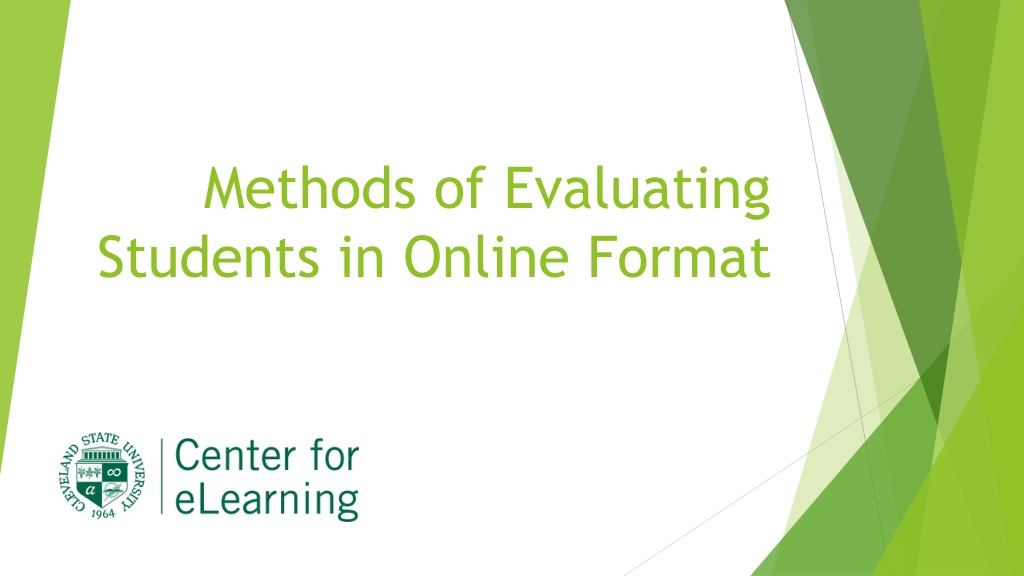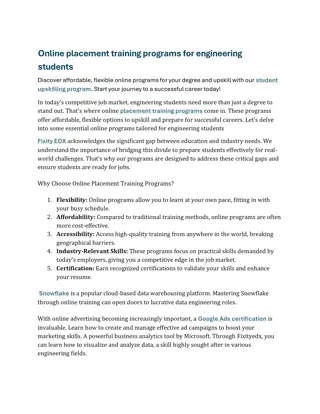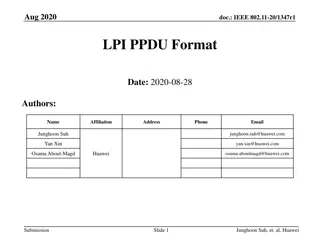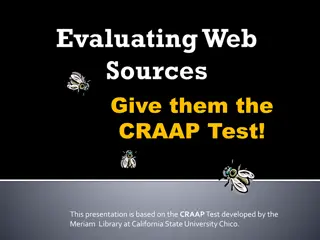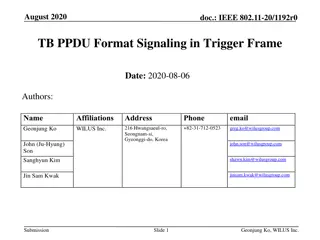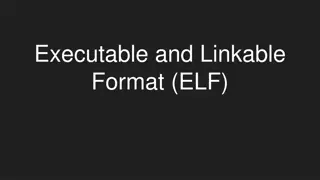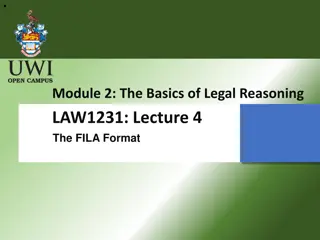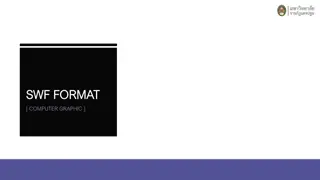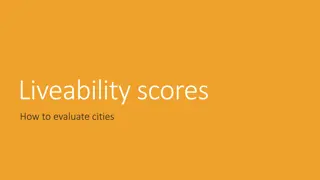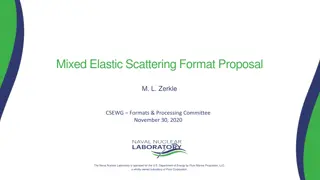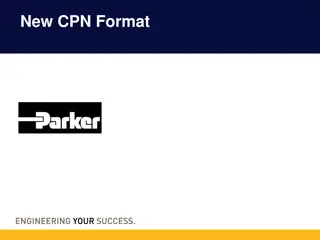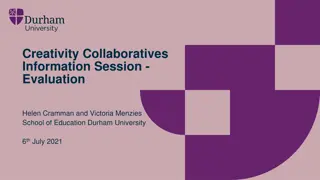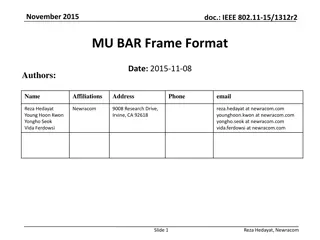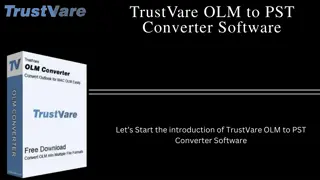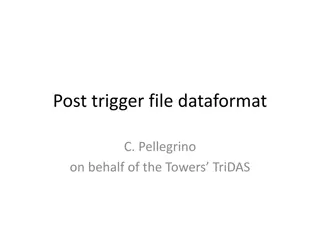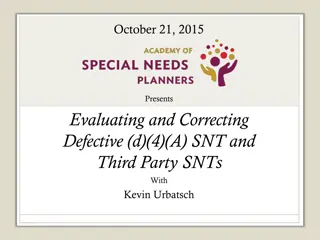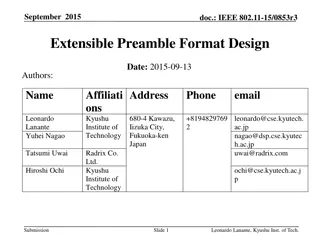Methods of Evaluating Students in Online Format Today
This presentation explores methods for evaluating students in online education, addressing the importance of technological limitations, low vs. high stakes evaluation, and alternative evaluation categories such as quizzes, writing exercises, and student presentations.
Download Presentation

Please find below an Image/Link to download the presentation.
The content on the website is provided AS IS for your information and personal use only. It may not be sold, licensed, or shared on other websites without obtaining consent from the author.If you encounter any issues during the download, it is possible that the publisher has removed the file from their server.
You are allowed to download the files provided on this website for personal or commercial use, subject to the condition that they are used lawfully. All files are the property of their respective owners.
The content on the website is provided AS IS for your information and personal use only. It may not be sold, licensed, or shared on other websites without obtaining consent from the author.
E N D
Presentation Transcript
Methods of Evaluating Students in Online Format
Methods of Evaluating Students in Online Format Today s Presenters: Sam Diomede, Sr. Instructional Designer Samantha Kissel, Online Course and Materials Developer LeAnn Krosnick, Sr. Instructional Designer
Why is this Important Now? Technological Limitations Low Stakes vs. High Stakes Evaluation Alternative Evaluation Methods
Alternative Evaluation Categories Low Stakes Quiz (formative) Writing Research/Critique Problem Solving/Equations Student Presentations
Low Stakes Quiz: Formative/Diagnostic Quizzing Helps assess learning as you progress through it. Low-stakes focused on conceptual touchpoints Frequent engagement and recall No need to be as dependent on Academic Integrity Software Individual: Group: Subject Areas: All Goals: Reinforces learning throughout Provides feedback to instructor Tool(s): BB Quiz, Survey or Assignment Evaluation: Multiple Choice graded by BB, Survey not Graded, formative assignments will be graded by instructor
Writing: Journaling Continuous writing exercise - could have weekly prompts leads to bigger vision or goal Individual: Group: Subject Areas: Can be used in most subject areas. Especially useful in humanities, writing, and sciences. Goals: Build writing skills Reflect on their thoughts and experiences Tool(s): Word Processor or BB Journal Tool Evaluation: An assessment of some form is linked to the journal. The points can be supplied as the journal progresses or at the end.
Writing: Zine A handmade or digital magazine that can be about anything. May contain Short articles, Images, Poetry, Interviews etc. Individual: Group: Subject Areas: Can be used in most subject areas. Goals: Integrate visual information with other information Write explanatory texts (historical, scientific, technical) Synthesize information into one cohesive text Develop research skills Tap into creativity combined with academics Tool(s): Microsoft Word, Microsoft Publisher, Various magazine creation software Evaluation: A rubric would work best to make sure student completes all components.
Writing: Wikis/Collaborative Writing Students work on the same document Collaboratively. A shared google doc is a good example. Individual: Group: Subject Areas: All Goals: Help combine several student perspectives into a single document, Work collaboratively with other students to better understand and succeed at group processes Synthesize a collective work into a cohesive document Facilitate Group Sign-ups Tool: BB Wiki Tool Evaluation: Participation can be assessed. History of edits. A rubric can be used to help gauge the quality of the contribution.
Writing: Essay/Research Report Essay: Students are given a question on which to write the essay. Evaluates how well student understands the question and is able to answer it. Research Report: The purpose of a Research Report is to demonstrate or develop a student's ability to undertake a complete piece of research including research design and an appreciation of its significance in the field. Individual: Group: Subject Areas: Most areas, although less common in Mathematics, Materials Sciences, Chemistry, Physics, and Engineering. Goals: Gain a deeper understanding of a given topic. May also assess W.A.C skills. Tool(s): Word Processor, Turnitin or Safe Assign, BB Assignment, Access to Online Library Evaluation: Grade based on rubric. Consider: Peer Reviews. Draft low stakes assignments. Students submit works-in-progress so that they can receive early written feedback and a small grade, which could consist simply of a check or check-minus.
Research/Critique: Literature Review Research a topic and prepare a report Use a theory and evidence to support a research question Expose undergrads to academic writing Individual: Group: Subject Areas: All Goal: Develop an advanced level of knowledge about a given topic Perform literature research, critically review literature Evaluate sources, synthesize information Tool(s): Word processor, Turnitin or Safe Assign, BB Assignment, Access to Online Library Evaluation: A rubric can work for evaluating the different parts of the paper.
Research/Critique: Article Critique Each student is assigned an article to critique - then report on that article AND may be required to peer review other students critiques. Individual: Group: Subject Areas: All Goal: Teach students the contents of the articles at an evaluative level Internalize current studies in the field and develop such a habit Introduces students to the appropriate journals for the given field Tool(s): Word processor, Turnitin or Safe Assign, BB Assignment, Access to Online Library Evaluation: A rubric can work for evaluating the article critique.
Problem Solving/Equations: Case Study A case is presented to students, leading them to a correct response or solution, or an understanding of the ramifications of their decision. Individual: Group: Subject Areas: Useful in law, business, engineering, teacher, and medical education, but can be modified to most curriculum. Goals: Assess the appropriate action in the given situation Generalize patterns within cases Develop a theory concerning the cause of a given case Identify the components of a given case Summarize a case Tool(s): BB Assignment Tool, BB Group, BB Teams, BB Discussions Evaluation: BB Discussions, Case Report Assignment, Peer Reviews, Use Rubrics to guide students work and help assign grades
Problem Solving/Equations: Group Debugging Finding a problem in a program/equation and suggesting solutions. Useful in subjects that have programs or equations. Can take 15 minutes to an hour depending on the problem chosen Individual: Group: Subject Areas: Can be used in Mathematics, Computer Science, Engineering, Chemistry, or Physics Goals: Develop knowledge of coding/theory/equation solving Evaluate and decipher code/equation to find a problem Provide a solution Tool(s): Synchronous screen sharing, Math/Code writing programs Assessment: Can be based on finding the error and providing a solution.
Student Presentations: Presentations Students present a given topic to the class or a group of students typically using conferencing software. Types: Personal Recording, Group Presentation through Blackboard Collaborate, PowerPoint, Demonstration Individual: Group: Subject Areas: All Goals: Help students gain deeper understanding of content Help develop presentation skills Demonstrate evaluative level understanding of given concepts Link various concepts into a cohesive presentation Tools: Panopto, Blackboard Collaborate, Zoom, Any tool where students can upload screenshare and/or recording and share with class (Youtube, Camtasia, etc.) (Note: Students don t necessarily need a webcam to do a presentation.) Evaluation: Assessment based on pre-determined requirements that can be communicated in a rubric.
Live Synchronous Assessment Ideas Hold a Think-Pair-Share with Breakout Rooms Evaluate Student Presentations through Live Synchronous Environment (Zoom, Blackboard Collaborate) Polling To Assess Learner Knowledge at Anytime (Poll feature, Chats) Share Your Screen To Work on a Group PPT/Or use MS Teams Post-Session Reflections/Discussion
Additional Resources Writing CSU Writing Center & W.A.C Support Rubric Examples CSU Office of Student Learning Assessment Case Study Resources Creating Active Learning Classrooms Is Not Enough: Lessons from Two Case Studies (2017). Retrieved March 23, 2020, from https://er.educause.edu/arti cles/2017/12/creating-active-learning-classrooms-is-not-enough-lessons-from- two-case-studies Ethics in Electrical and Computer Engineering Lectures #6-#8: Case Studies for the Design Process. Retrieved March 23, 2020, from http://www2.ece.ohio- state.edu/~passino/ECE3080Lectures/Lecture6-8Cases.ppt.pdf
